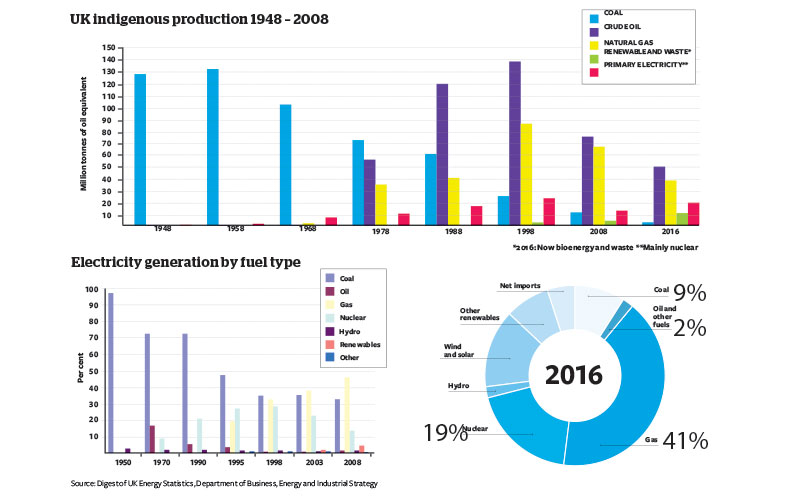A changing energy landscape: 75 years in the UK industry
First coal, then oil, the shift to a low-carbon future marks the third transition for UK energy systems since the EIC was formed in 1943. Jeremy Bowden looks at the effectiveness of the new power generation mix and how the country can become more self-sufficient.

As the EIC commemorates its 75th anniversary, the UK energy sector is embarking on perhaps its greatest challenge so far by moving towards decarbonisation. However, the end goal remains to ensure that energy demand efficiently meets the standards of the day. Over the past 75 years, this has involved various challenges and ongoing transformation, particularly from the late 1970s onwards.
When the EIC was established in 1943, the UK relied heavily on domestic coal for power generation and heating, importing all its oil and using almost no natural gas at all – gas for heating came from city gas, normally produced from coal. As domestic coal production began to fall in the 1950s and 1960s, energy supply from abroad climbed steadily, making the country ever more dependent on imports – far more so than at any other point in the UK’s history, including today.
Then came the first major transformational event, which proved to be of huge benefit for UK plc and British companies alike: in May 1964 the Continental Shelf Act came into force in the UK and the first offshore gas discovery, West Sole, followed shortly after in September 1965. The fields that were subsequently discovered have provided large quantities of both oil and gas for the UK and continue to do so today – improving the UK’s energy independence, balance of trade and growth levels in the process.
At the same time, an ambitious programme of nuclear plant construction began, building capacity that would meet 20% to 30% of the country’s electricity demand from the early 1970s up to the present day. While that power has been reliable, and the sector largely accident-free, the cost has been inflated by the clean-up required from a period when health and safety rules – along with risk awareness – were less rigorous than today.
50% of the UK’s energy is being produced by renewable sources. This technology is driving change and in the next 10 years our next revolution
will take place
Since then, coal has been cleaned up and now all but phased out, with gas largely taking its place in heating and power generation. State energy assets have been sold off, markets opened and deregulated. After rapid expansion in the 1960s and 1970s, refinery and fuel retail networks contracted sharply, especially with greater competition from supermarkets in the 1990s. For North Sea oil and gas, sharp growth levelled off in the late 1980s and over recent years the area has reached maturity. Declining output now means imports once again make up a significant portion of oil and gas supply, while subsidies have encouraged the growth of renewable power – which should eventually make the country self-sufficient again.
Focus on efficiency
Looking at where the industry is today, the focus among those active in the North Sea is firmly on cost and efficiency – squeezing the most out of the remaining reserves at the lowest possible cost – with the sector leading the world in technological innovation: ‘North Sea oil and gas technology innovation has advanced in leaps and bounds in recent years. The next step will be the implementation of real-time technologies that offer operators the chance to access data at the touch of a button. One example of this will be wireless reservoir monitoring, providing companies with reliable, consistent wellbore information. Not only will this enable safer operations, it will also allow operators to make faster and better-informed decisions,’ says Mark Tolley, CEO of Acoustic Data.
To coordinate efforts in the North Sea and lead the drive to improve efficiency – which has seen CAPEX and OPEX costs fall by 30% to 40% in the last three years – the Oil and Gas Authority (OGA) was established in 2015, following the conclusion of the Wood Review. The OGA was incorporated as a government company in October 2016.
Spencer Linsell, Sales Director at PJ Valves, says, ‘The UK North Sea has had its fair share of tough times but remains progressive. As projects become more challenging, operators will have to work in ever-harsher conditions and manage ever-more complex project specifications. This presents a huge opportunity for the UK supply chain to offer its expertise and innovation to support the next phase of growth in this famously challenging basin.’
In the power sector, it is wind, and especially offshore wind, that looks set to dominate the future, with larger, more productive turbines helping the costs of the latest proposed projects reach comparable levels to new gas plants – meaning subsidies may soon no longer be needed. Wind is already capable of generating up to a third of the UK’s power needs, but only when the wind blows. When it fluctuates, careful balancing with gas and other flexible sources is required – a key challenge for the future.
‘The new millennium is bringing a revolution in the electrical generation and transmission market. A growing movement to renewable energy sources has changed the dynamic of the grid and the drive to reduce our reliance on electricity generated using carbon-based fuel brings with it challenges in capacity and meeting demand. We have seen, in the UK, a growing reliance on short-term operating reserves to help support the grid and keep the lights on,’ says Keith Robertshaw, Business Development Director at N-ERGY.
‘Up to 50% of the UK’s energy is being produced by renewable sources. This technology is driving change and in the next 10 years our next revolution will take place – we could see more reliance on micro-generation schemes, islanded power sources and less reliance on large infrastructure.’

Shale and CCS
The need to balance renewables means gas will be needed for some time to come, so shale drilling remains on the table. In 2010, the first shale gas exploration well to be hydraulically fractured, Preese Hall-1, triggered two seismic events that led to the temporary suspension of activity while Cuadrilla Resources carried out investigations. However, new wells are planned for 2018 and the first UK shale gas could be supplied to customers in the next year or two (US shale gas has already arrived in the form of liquefied natural gas).
Carbon capture and storage (CCS) from hydrogen production to replace gas in heating, as well as from burning gas for power generation, now also appears to be back on the table. Looking further ahead, new nuclear, notably the Hinkley Point C project, should help replace baseload coal completely beyond 2025, along with more wind power, biomass and biogas. Batteries – possibly in the form of electric vehicles – will increasingly supplement gas and stored hydro as peak backup, as well as for grid balancing.
The transition to a low-carbon economy, if successful, will not only lead to lower greenhouse gas emissions, it will also bring energy independence and self-sufficiency. It will also mean a greater self-reliance – the future lies very much in the hands of UK companies.






Follow us
Advertise
Free e-Newsletter